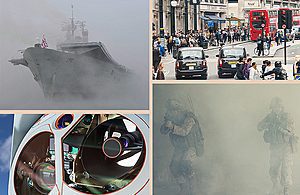Chelmsford, UK — Teledyne e2v is pleased to announce that it is well underway on the development of a UK-designed detector capability for infrared wavelengths that will lead to an exportable family of infrared detector products.
The areas of development that funding has been awarded for are:
III-V detectors relate to a group of semiconductor compounds listed in the 13th and 15th column of the periodic table and referred to as III-V, whereas other infrared detectors may be referred to as II-VI. Find out more here.

First announced at the UK Space Conference, September 2019 in Cardiff, Wales, by Defence Science and Technology Laboratory (Dstl), Teledyne e2v was awarded funding from the Space to Innovate Phase 1 competition and will be delivering prototype III-V barrier diode wafers and detector packages for radiation tolerance hardness testing and characterisation.
During March 2020 under the Defence and Security Accelerator (DASA) competition – “Advanced Vision for 2020 and Beyond”, Teledyne e2v was awarded the maximum amount achievable from the competition for “deep-dive” investigations and development of two-colour type-2 super lattice (T2SL) detector technology.
Peter Stocken, Business Development Manager – Space & Defense Imaging at Teledyne e2v said: “It is fantastic to be part of a world class team developing a new and novel infrared detector capability, the funding awards will accelerate the realisation of this technology and they reflect the high confidence in Teledyne e2v’s development in detector and associated technologies.”
Andy Cole, Dstl Project manager said: “The ever evolving nature of military operations means that we wish to invest in novel and resilient technologies that can function in contested and congested environments, that will extend the range, lower the cost and size, and expand the range of targets that can be addressed by EOIR sensors.”
Teledyne e2v has expertise and significant heritage in the development of custom CCD and CMOS image sensors, radiation effects characterisation, space qualification of systems and devices, up screening of commercial-off-the-shelf (COTS), ROIC design, detector packaging, and specialist coatings and quantum efficiency (QE) enhancement techniques, including proprietary and world-class back-thinning of image sensors, covering the full spectrum from x-ray, ultraviolet through visible and near-infrared.
Teledyne e2v is working with Amethyst Research Limited in the development of III-V and T2SL detectors. These developments will enable a new generation of extended short wave infrared (eSWIR), medium wave infrared (MWIR) and long wave infrared (LWIR) detector solutions for a range of standard and custom resolutions for space, defense, astronomy and scientific applications.
Further information can be found at:
About Teledyne e2v
Teledyne e2v is a part of the Teledyne Imaging group. Their innovations lead developments in healthcare, life sciences, space, transportation, defense and security, and industrial markets. Teledyne e2v’s unique approach involves listening to the market and application challenges of customers and collaborating with them to provide innovative standard, semi-custom or fully-custom imaging solutions, bringing increased value to their systems.
In combination with its sister companies, Teledyne DALSA and Teledyne Imaging Sensors, three imaging powerhouses, together represent a new paradigm in the delivery of innovative imaging solutions built on unrivalled expertise and a deep technological heritage that includes capabilities across the spectrum, from infrared to x-ray imaging.
About Teledyne Imaging
Teledyne Imaging is a group of leading-edge technology companies aligned within the Teledyne brand. With unrivalled expertise across the electromagnetic spectrum and decades of experience, the group offers world-leading capabilities in sensing, signal generation and processing. The collective delivers innovative solutions to aerospace, defense, geospatial, machine and industrial vision, medical and life sciences, semiconductors and MEMs